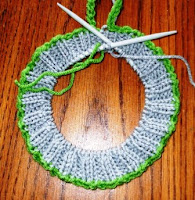This post will remain on line to offer help when you are working my Pattern called Callum #12-012. If you have my pattern you can follow the process along with the written instructions. The Pattern will be available on Patternfish in June of 2012.
(1) NECKBAND
Begin with a crochet chain with approx 10 more chain stitches than the required number of Cast-On stitches for the Neckband. Cut yarn, pull the end of the yarn through the last chain stitch. Tie a knot at the finished end to indicate which end to begin picking up the stitches and which end to begin removing the chain when the Neckband is finished.
Turn your chain over and in the back you'll see horizontal "bumps". Pick up and knit the required number of stitches for the size needed through the bumps.
Join in the Round being careful not to twist stitches.

Work the rib stitches until neckband is the required length from the cast-on stitches.

When the neckband is the required length, turn the knitting inside out to remove the Crochet Chain. Working from the knotted end of the chain, pull the tail through the last chain stitch and begin to rip the chain back to the first picked up stitch. Place the stitches on the smaller short circular needle, as you rip out each stitch of the chain.
Fold the neckband back with the right side of the ribbed stitches on the outside. Hold the two circular needles parallel.


Insert the front circular needle into the first stitch on each needle, knit the two stitches together, repeat knitting the stitches together to the end of the round.
Neckband is complete.
(2) BACK PANEL
The back panel is worked on the back of the neck stitches. The side of neck stitches and the front of neck stitches are placed on scrap yarn. Then the PANEL PATTERN is worked on the double pointed needles. When working the panels do not slip the first stitch on each row as the stitches along the sides of the panels are picked up 1 stitch for every row, to accommodate the cables worked within the next panel.
When the Back Panel is completed the stitches are placed on a piece of scrap yarn.
(3) RIGHT SHOULDER PANEL
The Right Shoulder Panel stitches are picked up along the left side of the Back Panel and then worked across the side of the neck stitches that are on the scrap yarn. The panels are worked using double pointed needles
The number of Shoulder Panel stitches are equal in number to the Centre Back Panel stitches so that the same Panel Pattern applies to the Centre Back Panel and also the two shoulder panels. Depending on the size, the number of repeats of the Panel Pattern is specified in the Pattern.
When the Right Shoulder Panel is finished, place the stitches on a piece of scrap yarn.
(4) LEFT SHOULDER PANEL
Next we move on to the Left Shoulder Panel. The side of the neck stitches are placed on the double pointed needle and then the stitches are picked up along the Right Side of the Centre Back Panel. Once again the total stitches that end up on the needle are the same as the number on the Centre Back Panel.
 |
| In this picture the back panel is on the top of the picture. |
 |
| Both Shoulder Panels are now complete |
Depending on the size, the number of repeats of the Panel Pattern is specified in the Pattern the same number of rows are worked as on the Right Shoulder Panel, then the stitches are placed on scrap yarn.
(5) FRONT YOKE PANEL
The Front Yoke Panel is worked next. The number of stitches on the yoke panel make it necessary to change to the larger, longer circular needle. The required number of stitches are picked up and knit along the Left Side of the Right Shoulder Panel. The number of stitches picked up depends on the number of repeats of the Shoulder Panels that are specified for each size. Then the set up row for the centre yoke cable is worked, then the required number of stitches are picked up and knit across the Right Side of the Left Shoulder Panel.




















No comments:
Post a Comment